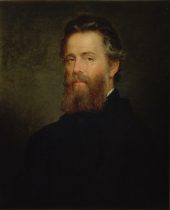
Biography
Herman Melville (1819-1891) is an American author who wrote novels, short stories, and poems. He grew up in New York state. His family struggled with poverty after the death of this father in 1832 after having already struggled with the failure of the family import business two years earlier. Melville ended up spending much of his young adulthood working on ocean voyages, being unable to find lucrative work on land. Much of his seafaring experiences inspired his later work. For example, Melville gained fame for his 1846 novel Typee, which was inspired by his time anchored in the Marquesas Islands in what is now French Polynesia.
Melville married Elizabeth Shaw in 1847, and later moved to a farm in Massachusetts where he wrote the novel Moby-Dick. This novel, about a sea captain who relentlessly chases after a particular whale, was not exceedingly popular when it was first published in 1851, but it is now his most famous work. In 1852, the publication of his deeply personal work Pierre, which faced a negative reception, as well as a fire at his NYC publishers, led to the decline of his writing career. Years later, he switched from writing novels to writing poetry. He did write one last novel, Billy Budd, before his death in 1891 at the age of 72, although it was not published until after his death.
Melville was very connected to New York City. He was born in NYC, lived most of his life in the Northeast United States, and had a New York City publisher. In 1863, he and his family moved from their farm in Massachusetts, which they could no longer afford, to a townhouse in the Flatiron District of New York. There is now a plaque at the location recognizing him. Additionally, the intersection of 26th Street and Park is named “Herman Melville Square.” He included New York City in his novels Moby-Dick and Pierre, and his short story “Bartleby, the Scrivener,” written for Putnam’s Monthly Magazine, is set entirely in the city. This story, subtitled “A Story of Wall-Street,” is based on the world of lawyers and copy-clerks in New York’s financial district in the mid-nineteenth century.
Some of Melville’s major works include the novels Typee (1846), Moby-Dick (1851), Pierre (1852), and Billy Budd (1924, published posthumously), as well as the short story “Bartleby, the Scrivener” (1856).
Link to “Bartleby, the Scrivener”: https://www.bartleby.com/129/
Fun Fact: While writing Moby-Dick at his farm, “Arrowhead,” in Massachusetts, Melville was neighbors with fellow American author Nathaniel Hawthorne, who wrote The Scarlet Letter.
Works Consulted
“Herman Melville.” Flatiron 23rd Street Partnership. 1 October 2013, http://www.flatirondistrict.nyc/discover-flatiron/flatiron-history/herman-melville. Accessed 1 May 2019.
Lopate, Phillip. “Herman Melville.” Writing New York: A Literary Anthology, edited by Phillip Lopate, Library of America, 2008, p. 153.
Maxwell, D. E. S. “Herman Melville.” Encyclopedia Britannica. https://www.britannica.com/biography/Herman-Melville. Accessed 1 May 2019.
Analysis of “Bartleby, the Scrivener”
Herman Melville’s “Bartleby, the Scrivener: A Story of Wall Street” deals with the struggles of the working class in nineteenth century New York City. More specifically, it comes from the perspective of someone in a more privileged position wondering what he can do for another in a lower position. The narrator, who is in charge of a small law office, is at a loss as to what to do about his strange employee without being cruel.
In “Bartleby, the Scrivener,” the narrator runs a law office. When his new employee, Bartleby, refuses to do the work that is expected of him, he does not know what to do. The narrator ends up keeping him on because he is afraid that Bartleby would be treated poorly by a less forgiving employer. He feels sorry for him at the same time as he is irritated with him. His pity for Bartleby continues as he discovers that his employee has been living at the office. Even though eventually the narrator gives up on keeping Bartleby as an employee when he stops doing any work whatsoever, the narrator continues to try to do right by him. For example, when he informs Bartleby that he will be terminating his employment, he offers to be of service if Bartleby needs help in his next place. Eventually, after moving his office away from the place that Bartleby refuses to leave, and after Bartleby is arrested and taken to prison, the narrator goes to visit him and ensures that he will be fed well. Ultimately, he is powerless to help Bartleby, but he does what he can.
Bartleby’s bizarre refusal to ever do what he is asked makes him a very unusual character, and not the type of person one is likely to meet in real life. However, it is possible that his relationship to the narrator is symbolic of the relationship between the relatively privileged and the totally powerless. The narrator can only do so much to help Bartleby. Although he does what he feels he can, there are more powerful forces at work than him and he cannot save Bartleby from them. In this way, the text concerns the way that the relatively privileged, even those with good intentions, cannot easily help the mistreated less fortunate because the powerful system is working against all of them.
Works Cited
Melville, Herman. “Bartleby, the Scrivener.” Writing New York: A Literary Anthology, edited by Phillip Lopate, Library of America, 2008, pp. 153-190.